I’ve recently been asked about plants and solutions for a windy garden.
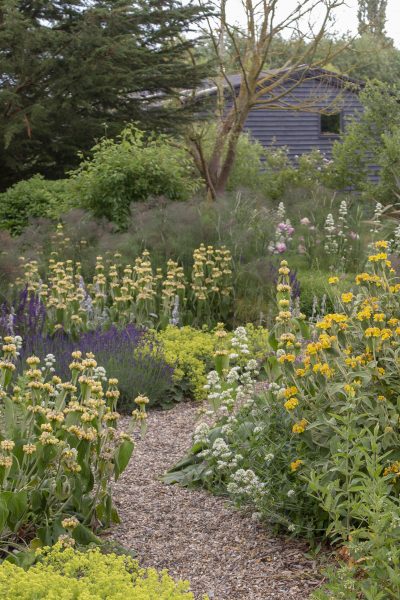
Sue Marling and Fay Sweet’s Suffolk garden is in a windy area, but it is colourful and feel sheltered. The plants which love the conditions – the low-growing Alchemilla mollis and the tall spikes of Phlomis russeliana, along with salvias, have spread.
Even if you don’t have a windy garden, you probably have a windy spot. Our walled garden gets windy in the middle, which is quite common.
I’ve made a mistake with planting too tall a young tree there. We’ve secured it with several stakes. But it gets pushed over again when the wind changes direction. I actually chose the right type of tree – a Liquidambar – for a windy spot, but it was too tall when I planted it.
Check the gardens in a windy town
And not long after being asked about plants for windy gardens, I went to the charming beach town of Southwold shortly afterwards.
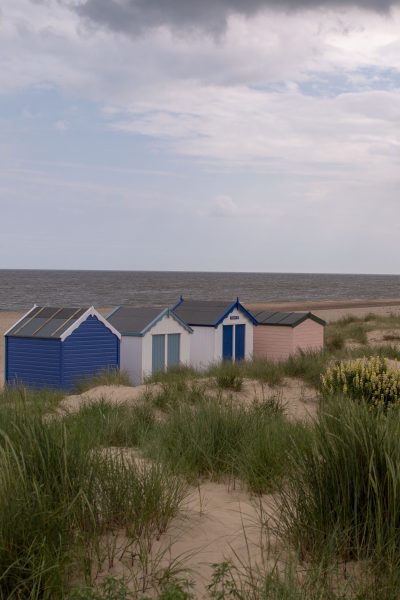
It’s always useful to look at what grows naturally – here on this windy Southwold beach, there are lots of grasses.
Southwold is a delightful former fishing village on the Suffolk coast, and it dates back hundreds of years. But Suffolk is quite flat near the coast. And all seaside towns get their fair share of wind.

The Crown Hotel at Southwold. It was a Georgian and Victorian fishing town, and is now a well-loved holiday place.
A garden in Southwold is definitely a windy garden. So as I was visiting in midsummer, I thought I would see what was flourishing in the Southwold gardens, and along the beach.
If you prefer to see a video, rather than read a post, see The Middlesized Garden YouTube channel on windy garden solutions.
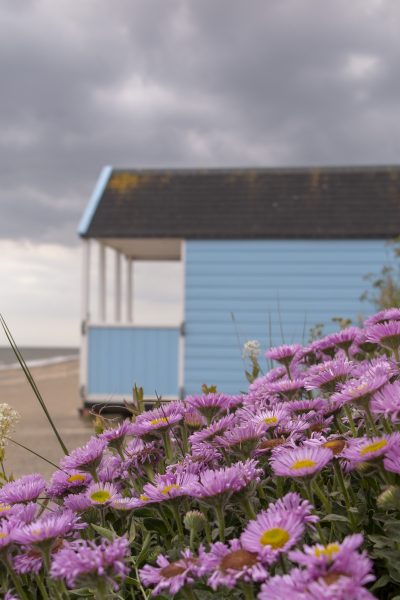
I saw lots of clumps of these very low growing asters (now known as Symphotricum) everywhere in Southwold. Even though they’re a common garden centre plant, they look good in groups.
Expert advice on choosing windy garden plants
First I spoke to Rosy Hardy of Hardys Cottage Garden Plants. Hardy’s Cottage Garden Plants is one of the leading plant nurseries in the UK.
Rosy had three pieces of very useful advice as well as suggestions for plants.
‘Choose shorter varieties of your favourite plants if your garden is windy,’ she suggests.
‘Or you can choose plants which are meant to blow about in the wind, such as grasses or gaura,’ advises Rosy Hardy.
Sue Marling and Fay Sweet, whose garden is featured here, have created a successful garden near Southwold. They have found that salvias, Phlomis russeliana and fennel have all done well in their garden. They are all plants that can sway in the wind.
And they also have Alchemilla mollis, which fits into Rosy Hardy’s ‘low-growing’ category, as do the asters all over Southwold beach.

Gaura ‘Rosyjane’ is one of Hardy’s Cottage Garden plants and is ideal for a windy site.
And thirdly,’ says Rosy: ‘Plant trees and shrubs dotted about the garden to break up the wind. Don’t plant in a line.’
Specific plants she recommends for a windy garden include hardy geraniums, especially the Oxonianum ‘Lace Time’. Amongst the grasses Stipa Tenuissima always looks good’, she says. And she also recommends the long slender stems of Gaura Rosyjane, which is an elegant flower with a picotee petal.
Japanese anemones are also tough enough to survive windy conditions, and Rosy suggests you try an unusual variety such as the ruffled ‘Swan’ series.’

Japanese anemones (Anenome x hybrida) do well in a windy garden, so choose a special variety such as this Ruffled Swan from Hardy’s Cottage Garden Plants.
Hardys Cottage Garden plants stock all these.
The RHS on trees and shrubs for windy gardens
One important thing to understand about wind is that it whips up a solid fence or wall, and then drops down creating turbulence on the other side. That’s why hedges and shrubs, which break up the wind rather than block it, are better than fences and walls. And a very thick line of evergreens can act more as a fence or block rather than a filter, so the RHS recommend choosing a mix of deciduous and evergreen trees and shrubs.

Sue and Fay have surrounded their garden with a mix of trees and shrubs around the boundary – and there’s a hedge behind the trees. The garden feels sheltered and secluded although the Suffolk winds can be quite strong.
Trees and shrubs won’t grow as tall in windy conditions but they are so important for breaking up the wind. The RHS has a page of recommendations for trees and shrubs that do well in exposed sites. These include some pines, hawthorn, Norway spruce and holm oak, all of which I love. Good shrubs include black elder and pinus mugo (dwarf pine).
Roses do well in a windy garden
One thing that really surprised me as I walked round Southwold was how well roses were growing. They seemed to be blooming in every garden.

This white climbing rose seems very happy amongst the winds of Suffolk.
So I contact Michael Marriott of David Austin Roses. He confirmed that that roses often do very well in windy places. Some original species roses came from quite inhospitable places – Rosa rugosa came from Northern Japan and Siberia, for example, and the Spinossisima roses (often called ‘Scotch roses’) are basically coastal plants.
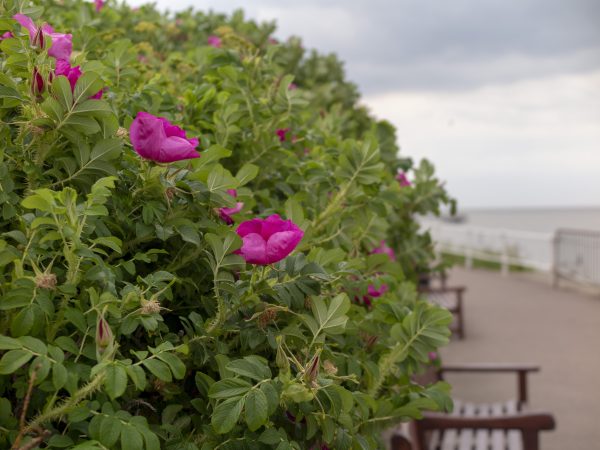
Rosa rugosa ‘Rosarie de la Haye’ tumbling over a front garden wall onto the beachfront at Southwold.
Roses in windy gardens won’t grow as tall, he says, and you do have to pick and choose your varieties, but they are a great plant to add.

Rosa rugosa Gap from David Austin roses – will do well in windy gardens.

This is David Austin Roses’ Dunwich Rose. Dunwich was a sea port just along the coast from Southwold, Most of it was reclaimed by the sea, so only a few houses now remain. Not surprisingly, the Dunwich Rose does well in exposed sites!
But choose your rose carefully
When choosing roses for a windy garden, Michael suggests you firstly think of the flowers – single flowered or semi-doubles will be better than big showy blooms of hybrid teas.

‘Kew Gardens’ rose from David Austin Roses is recommended for windy spots.
And think about how the plant grows – a rambling rose will create a lot of body which can be buffeted in the wind. The stiffer and more individual stems of a climbing rose will give the wind much less to blow about. And keep tying a climber in if you have a windy garden.
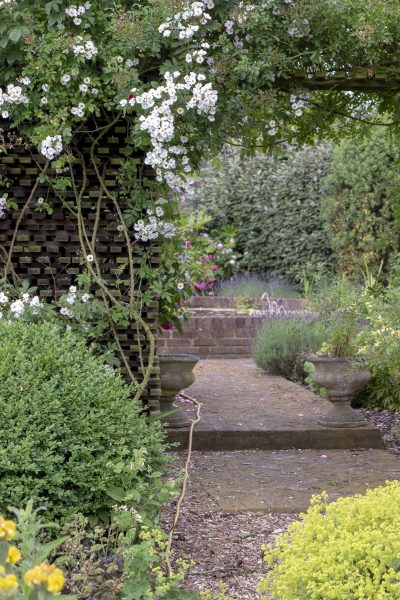
Roses growing over Sue and Fay’s windbreak-cum-wildlife home (see later on in this post). This is a small single-flowered rose with a few stiff stems that can be tied in. Good for a windy garden!
Break up the wind for a sheltered spot
In terms of a sheltered spot to sit in, consider a broken screen rather than a solid one. There is a terrific range of laser-cut screens around these days, such as this one from Stark & Greensmith.

This corten steel laser-cut screen from Stark & Greensmith breaks up the wind and offers privacy, but it isn’t a solid barrier.
And I’ve seen some great screening ideas at the garden shows this summer. For example, I like this slatted wooden screen inscribed with poetry from The Oak & Rope Company.
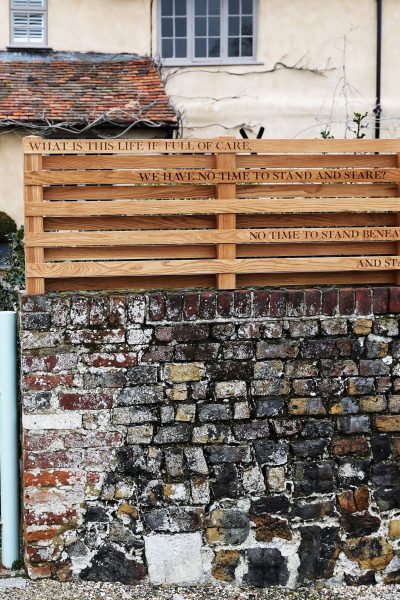
This is a slatted screen so it filters the wind. From the Oak & Rope Company.
Sue and Fay have created a wildlife-friendly screen by building a curved wall out of inexpensive roofing battens. It filters the wind, and offers a hideaway for insects. Fay built it herself, although she admits it was quite hard work.

Fay built this high semi-circular windbreak wall herself out of roof battens, laying them in a criss-cross pattern. The wall is about seven feet high, so it provides lots of shelter as well as supporting climbing plants like roses and honeysuckle.
And here is another easy DIY broken screen. These wood posts and strips of corrugated iron shield a washing line in this Australian coastal garden, while filtering the wind beside a seating area.
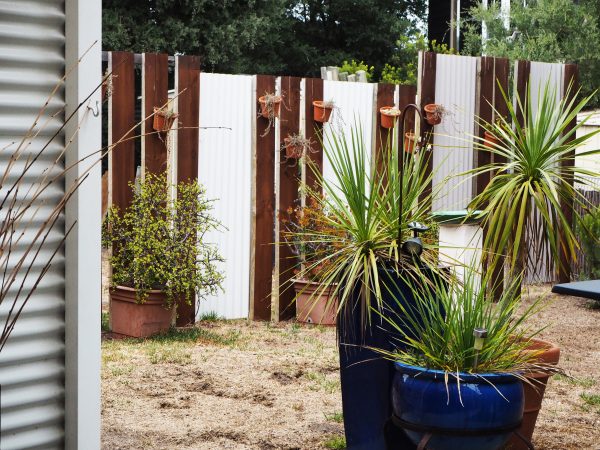
Corrugated iron and wood (possibly fence posts or railway sleepers) used to create a broken screen in coastal Australia.
If you’ve found this helpful, do share it on social media, using the buttons below. And if you’d like the Middlesized Garden blog to whiz into your inbox every Sunday morning, just sign up in the box on the top right of this page.
And if you’d like to see what July in the Middlesized Garden looks like, see this video:
Pin for reference

The post The best windy garden plants and solutions appeared first on The Middle-Sized Garden.
from The Middle-Sized Garden https://www.themiddlesizedgarden.co.uk/the-best-windy-garden-plants-and-solutions/
No comments:
Post a Comment